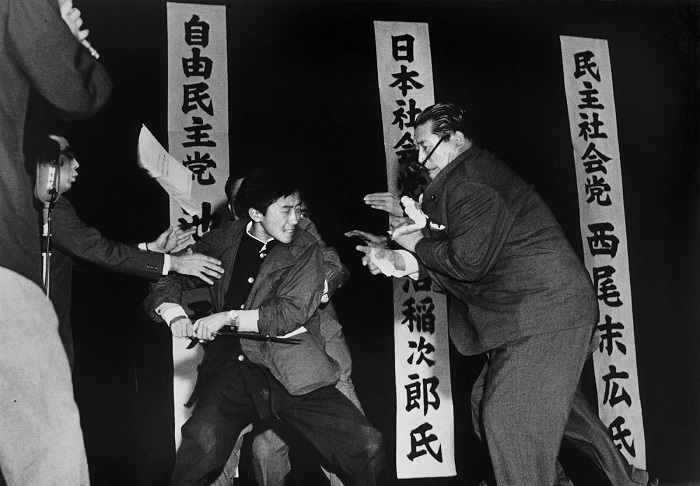Otoya Yamaguchi was a Japanese right-wing ultranationalist youth known for assassinating Inejiro Asanuma, the chairman of the Japan Socialist Party on live television. The Then-17-year-old stabbed the chairman with a sword while he was participating in a televised election debate at Hibiya Public.
After his arrest, Yamaguchi committed suicide in a detention facility. However, he was seen as a hero and martyr by the Japanese far right, and commemorations are held in his honor annually.
Otoya Yamaguchi’s Early Life and Background
Otoya Yamaguchi was born on Febuary 22 1943 in Yanaka, Tokyo. His father, Shinpei Yamaguchi, was a high-ranking officer in the Japan Ground Self-Defense Force. Otoya was also the maternal grandson of the famous writer, Namiroku Murakami.
During his formative years, Otoya started reading newspapers and became interested in nationalist movements. Through his brother’s influence, he started attending speeches and protests organized by various right-wing groups.
He assassinated Inejiro Asanuma during a televised debate

After several years of participating in the Anpo protests, Otoya Yamaguchi joined a large crowd of over 2,000 spectators at a televised election debate that was held in Hibiya Public Hall on 12 October 1960. The discussion featured Suehiro Nishio of the Democratic Socialist Party, Inejiro Asanuma of the Japan Socialist Party, and Hayato Ikeda of the Liberal Democratic Party.
Immediately Asanuma, who was the second speaker took the stage, Yamaguchi rushed to the stage and thrust a 33-centimeter samurai short sword into Asanuma’s ribs on the left side. He then tried to thrust himself also but was stopped. Asanuma later died from excessive internal bleeding.
The sword used by Yamaguchi is known as a yoroidoshi. It is one of the traditionally made Japanese swords worn by the samurai class in feudal Japan.
Apparently, the Japanese television company NHK had a video recording of the debate and it was later transmitted many times to millions of viewers.
Read Also: Gert Van Rooyen- 10 Things They Didn’t Tell You About The Dreaded South African Abductor
Otoya Yamaguchi’s arrest and suicide
Yamaguchi was arrested and incarcerated while he awaited trial. Meanwhile, he gave an extensive account of what he did and why he did it to the police. Barely three weeks later, the Japanese killer mixed toothpaste with water and wrote on his cell wall “Seven lives for my country. Ten thousand years for His Imperial Majesty, the Emperor!”. He then knotted strips of his bedsheet into a makeshift rope and used it to hang himself from a light fixture.
According to reports, Otoya Yamaguchi’s suicide was done in true samurai fashion to serve as an apology to his group for killing a person of authority.
Following his death, ring-wings groups celebrated him as a martyr. During a memorial service, his parents were given a burial coat, a kimono, and a belt. A nationwide coalition of Japanese right-wing groups also held a memorial service for him in the same hall he killed Asanuma.
The aftermath of the assassination
A photograph taken by Yasushi Nagao after Otoya withdrew his sword from Asanuma later went on to win the Pulitzer Prize as well as the 1960 World Press Photo Award. Reports say the footage of the assassination was also captured by the media.
Years after the assassination of the head of the Japanese socialist party, the Proud Boys, an American paramilitary group, and other far-right extremists portray Yamaguchi as a hero who fought communism. In 2018, the Proud Boys reenacted the 1960 assassination showing Yamaguchi as their great hero.
Seemingly, in recent times, Otoya Yamaguchi has been likened to other far-right discussion board supporters, one notable one is a teenager, Kylie Rittenhouse that was acquitted of murdering two men in Kenosha, Wisconsin.







